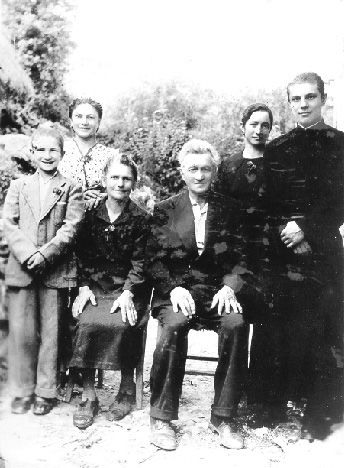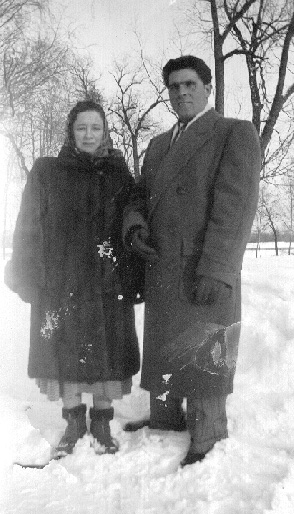|
|
| |
| Ada
DiNardo: One Woman’s Journey to Canada |
| By
Fiona Story |
| Ada
DiNardo never expected to come to Canada. Ada grew up on a farm in the
tiny town of Roccamontepiano,
in the province of Chieti, with her two younger brothers Rocco and Ettore
and younger sister Maria. Her parents planned for her to marry, stay
in Italy and raise a family of her own.
In 1939, she followed that plan and, at the age of
20, she married Palmerino DiNardo, a man living in the same village.
One year after their marriage he went off to fight in the Second World
War and never came back. He was proclaimed missing in action.
Sixty-one years later, sitting at her son’s
dining room table with her feet barely touching the ground, Ada says
she decided to move to Canada due to the conditions of life offered
by post-war Italy.
“I wanted something better, a better life,”
she shrugs.
|
|
So
Ada changed her parents’ plan. She turned down an offer of
marriage from Rocco DiNardo, another soldier in the war from her
village. And in 1949, Ada wrote to Palmerino’s cousin, Rosa
Tiezzi, in Canada. Rosa applied for Ada to immigrate and work as
a maid in her house, even though there was no room for Ada.
“In
those days the immigration bureau would go and inspect the house
where you’d be staying,” says Ada. “Rosa showed
them her mother-in-law’s room and made excuses and said it
would be my room.”
Despite
her parents’ protests, Ada packed and left for Canada. Using
the money she had received from the Italian government in compensation
for the loss of her husband, Ada paid the 400 lira needed for the
passage to Canada. |
 |
| Ada
DiNardo (second from right) with her parents (sitting) and siblings. |
|
|
“The
boat trip took ten days and I was sick by the second day,”
she says.
It
was on this tiny boat, “Brazil,” that Ada first met
her good friend Rosina Talarico, who was coming to Canada to get
married, as Ada found out in later years. Marriage was a common
method of immigration to Canada and one of the easier ways. Ada
went the hard route.
“Tell
her about the captain on the boat,” her son George prods from
across the table.
Ada
shakes her head and shushes him with her hand, proclaiming that
it is not an interesting story. She waits a moment and tells it
anyway. Ada had landed her own room on the very tiny boat, courtesy
of the captain who developed quite the crush on her. By the second
night, the captain came to Ada’s room and asked her to marry
him, stating that he hated his job and wanted to settle down with
someone.
“I
told him to leave or I’d scream,” she says, adding that
she avoided him for the rest of the trip.
The
boat docked in Halifax and Ada had to take a 24-hour train ride
to Montreal. When she finally arrived in Ottawa, Rosa Tiezzi brought
her to stay at Franco DiNardo’s home, the uncle of her late
husband.
Ada’s
first job was working in a laundry on Rochester Street. Three months
later, she moved on to the Ottawa Civic Hospital where she steam-pressed
laundry. Ada worked eight-hour days, five days a week and on Saturdays
until one in the afternoon for $18 a week. It was good pay at the
time.
“You
have to work some place,” she says. “I liked it. I was
happy.” |
 |
| Ada
and her husband Rocco. |
|
One
year later, she applied for her sister to immigrate to Canada and
Maria eventually came to work at the Civic Hospital too. Some time
after 1953, brother Rocco joined the sisters and the parish priest,
Father Ferraro, helped him get a job shoveling snow at the train
station. Ada’s second brother, Ettore, became a Roman Catholic
priest and is currently serving as the parish priest for an Italian
community in New Jersey.
Ada
did not know any English upon her arrival in Canada and picked it
up one word at a time.
“One
word here, one there. I learned one a day, one tomorrow,”
she says.
She
attended English classes in the evenings at St. Anthony’s
School, however, a man she didn’t know asked her
out one night and this scared her so much that she never went back. |
|
Ada
admits her lack of English impeded her in the workplace when she
was starting out. She was so timid about using the language that
she continued her work without bathroom breaks because she did not
want to ask someone to take her place. After she developed a bladder
infection, she began to use English and even started to act as a
translator between the Italian patients and the medical staff.
Meanwhile,
the Rocco DiNardo from her past had been released from a prisoner
of war camp four years earlier and had made his way back to Italy.
He had gone to Ada’s parents’ house to ask for her hand
in marriage. Again.
“My
parents wrote me and told me,” she says smiling. “I
kinda liked him, you know.”
Rocco’s
entrance into Canada was delayed by two years because Ada’s
former husband had not been declared dead and a marriage to an immigrant
only had a 90-day window. Ada credits Father Ferraro with helping
her to get a death certificate.
In
1954, Father Ferraro married a newly immigrated Rocco DiNardo and
Ada DiNardo at St.
Anthony’s Church.
Ada
laughs, remarking how although she married twice, she has never
had to change her name. George, her eldest son, speculates that
DiNardo is as common a name in Italy as Smith is in Canada.
Rocco
and Ada have been married for 47 years and have four sons: Giorgio,
Giuliano, Italo and Elio. With the exception of Giuliano, who studied
accounting and works at London Life, all are employed in computer
and software-related fields. Ada quit work to raise her children.
Four boys were a handful. Her sons still remember fondly the door
they broke fighting each other, which remains broken today, and
the brand new couch they busted almost immediately after its arrival.
“What
can you do?” Ada shrugs. “Take a stick to them?”
Ada
returned to Italy only once after her arrival in Canada. Twenty-seven
years after she left, Ada took her boys for a visit but said that
Italy had changed and was not as she remembered it. She currently
holds no desire to go back.
“I’m
happy. I have my boys,” she says. “When I was young
I suffered but now I’m here. I’m proud of myself.”
Ada
has eight grandchildren and they flock around her like bees to a
flower, eager to hear her stories. Even in their forties, her sons
still listen intently as she speaks of her life.
Ada
isn’t the only one proud of what she’s accomplished. |
| This
article was originally published in the May 2001 edition of Il
Postino. |
|
| back
to the top |
|


